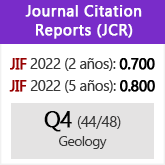La transición ediacárico-cámbrica: facies sedimentarias versus extinción
DOI:
https://doi.org/10.3989/egeol.43601.554Palabras clave:
Control de facies, Cordillera de Flinders, Ediacárico, AustraliaResumen
Un estudio reciente de la Cuarcita de Rawnsley, en el Ediacárico terminal Ediacaran de la Cordillera de Flinders, Australia meridional, demuestra cómo algunos taxones clave de la biota de Ediacara están restringidos a ciertas facies sedimentarias y determinados niveles estratigráficos. La Cuarcita de Rawnsleycomprende tres miembros separados por discotinuidades: (i) el Miembro basal de la Arenisca de Chace es somera y azoica, aunque destacan las superficies con texturas orgánicas; (ii) el Miemrbo de la Arenisca de Ediacara rellena un Sistema de incisiones submarinas que recortan el miembro inferior de Chace y la Arenisca parálica de Bonney, infrayacente a la Cuarcita de Rawnsley; y (iii) el Miembro de la Arenisca de Ediacara es asimismo recortada de forma erosiva por el Miembro de la Arenisca de Nilpena, menos fosilífera.
Descargas
Citas
Buatois, L.A.; Almond, J. & Germs, G.J.B. (2013). Environmental tolerance and range offset of Treptichnus pedum: Implications for the recognition of the Ediacaran-Cambrian boundary. Geology, 41: 519-522. https://doi.org/10.1130/G33938.1
Cohen, P.A.; Bradley, A.; Knoll, A.H.; Grotzinger, J.P.; Jensen, S.; Abelson, J.; Hand, K. Love, G.; Metz, J.; McLoughlin, N.; Meister, P.; Shepard, P.R.; Tice, M. & Wilson, J.P. (2009). Tubular compression fossils from the Ediacaran Nama Group, Namibia. Journal of Paleontology, 83: 110-122. https://doi.org/10.1666/09-040R.1
Counts, J.W.; Rarity, F.; Ainsworth, R.B.; Amos, K.J.; Lane, T.; Moro'n, S.; Trainor, J.; Valenti, C. & Nanson, R. (2016). Sedimentological interpretation of an Ediacaran delta: Bonney Sandstone, South Australia. Australian Journal of Earth Sciences, 63: 257-273. https://doi.org/10.1080/08120099.2016.1180322
Coutts, F.J.; Bradshaw, C.J.A.; García-Bellido, D.C. & Gehling, J.G. (2018). Evidence of sensory-driven behaviour in the Ediacaran organism Parvancorina: Implications and autecological interpretations. Gondwana Research, 55: 21-29. https://doi.org/10.1016/j.gr.2017.10.009
Darroch, S.A.F.; Sperling, E.A.; Boag, T.H.; Racicot, R.A.; Mason, S.J.; Morgan, A.S.; Tweedt, S.; Myrow, P.; Johnston, D.T.; Erwin, D.H. & Laflamme, M. (2015). Biotic replacement and mass extinction of the Ediacara biota. Proceedings Royal Society B, 282: 20151003. https://doi.org/10.1098/rspb.2015.1003 PMid:26336166 PMCid:PMC4571692
Droser, M.L. & Gehling, J.G. (2015). The advent of animals: the view from the Ediacaran: Proceedings of the National Academy of Sciences, 112: 4865-4870. https://doi.org/10.1073/pnas.1403669112 PMid:25901306 PMCid:PMC4413262
Droser, M.L.; Tarhan, L.G. & Gehling, J.G. (2017). The Rise of Animals in a Changing Environment: Global Ecological Innovation in the Late Ediacaran. Annual Reviews in Earth and Planetary Science, 45: 593-617. https://doi.org/10.1146/annurev-earth-063016-015645
Evans, S.D. Dzaugis, P.W.; Droser, M.L. & Gehling, J.G. (2018). You can get anything you want from Alice's Restaurant Bed: exceptional preservation and an unusual fossil assemblage from a newly excavated bed (Ediacara Member, Nilpena, South Australia). Australian Journal of Earth Sciences. https://doi.org/10.1080/08120099.2018.1470110
Gehling, J.G. (2000). Sequence stratigraphic context of the Ediacara Member, Rawnsley Quartzite, South Australia: a taphonomic window into the Neoproterozoic biosphere. Precambrian Research, 100: 65-95. https://doi.org/10.1016/S0301-9268(99)00069-8
Gehling, J.G. & Droser, M.L. (2012). Ediacaran stratigraphy and the biota of the Adelaide Geosyncline, South Australia. Episodes, 35: 236-246. https://doi.org/10.18814/epiiugs/2012/v35i1/023
Gehling, J.G. & Droser, M.L. (2013). How well do fossil assemblages of the Ediacara Biota time? Geology, 41: 447-450. https://doi.org/10.1130/G33881.1
Gehling, J.G. & Droser, M.L. (2018). Ediacaran scavenging as a prelude to predation. Emerging Topics in Life Sciences, 2: 213-222. https://doi.org/10.1042/ETLS20170166
Jenkins, R.J.F.; Ford, C.H. & Gehling, J.G. (1983). The Ediacara Member of the RawnsleyQuartzite: the context of the Ediacara assemblage (late Precambrian, FlindersRanges). Australian Journal of Earth Sciences, 30: 101-119. https://doi. org/10.1080/00167618308729240 https://doi.org/10.1080/00167618308729240
Jensen S. & Runnegar, B.N. (2005). A complex trace fossil from the Spitskop Member (terminal Ediacaran-? Lower Cambrian) of southern Namibia. Geological Magazine, 142: 561-569. https://doi.org/10.1017/S0016756805000853
Jensen, S.; Gehling, J.G.; & Droser, M.L. (1998). Ediacaran-type fossils in Cambrian sediments. Nature, 393: 567-569. https://doi.org/10.1038/31215
Narbonne, G.M.; Saylor, B.Z. & Grotzinger, J.P. (1997). The youngest Ediacaran fossils from southern Africa. Journal of Paleontology, 71: 953-967. https://doi.org/10.1017/S0022336000035940 PMid:11541433
Smith, E.F.; Nelson, L.L.; Tweedt, S.M.; Zeng. H.; and Workman, J.B. (2017). A cosmopolitan late Ediacaran biotic assemblage: new fossils from Nevada and Namibia support a global biostratigraphic link. Proc. R. Soc. B 284: 20170934 . https://doi.org/10.1098/rspb.2017.0934 PMid:28701565 PMCid:PMC5524506
Publicado
Cómo citar
Número
Sección
Licencia
Derechos de autor 2019 Consejo Superior de Investigaciones Científicas (CSIC)

Esta obra está bajo una licencia internacional Creative Commons Atribución 4.0.
© CSIC. Los originales publicados en las ediciones impresa y electrónica de esta Revista son propiedad del Consejo Superior de Investigaciones Científicas, siendo necesario citar la procedencia en cualquier reproducción parcial o total.Salvo indicación contraria, todos los contenidos de la edición electrónica se distribuyen bajo una licencia de uso y distribución “Creative Commons Reconocimiento 4.0 Internacional ” (CC BY 4.0). Puede consultar desde aquí la versión informativa y el texto legal de la licencia. Esta circunstancia ha de hacerse constar expresamente de esta forma cuando sea necesario.
No se autoriza el depósito en repositorios, páginas web personales o similares de cualquier otra versión distinta a la publicada por el editor.

















